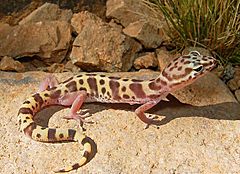Eublepharinae facts for kids
Quick facts for kids Eublepharinae |
|
|---|---|
 |
|
| The Western Banded gecko (Coleonyx Variegatus) | |
| Scientific classification | |
| Kingdom: | |
| Phylum: | |
| Class: | |
| Order: | |
| Suborder: | |
| Infraorder: | |
| Family: | |
| Subfamily: |
Eublepharinae
|
The Eublepharinae are a special group of geckos. They are one of five main groups within the larger gecko family. There are 27 different kinds, or species, of Eublepharinae geckos, found in five different genera (groups of similar species).
These geckos are also known as eyelid geckos because, unlike most other geckos, they have movable eyelids. This is one of the features that makes them unique! They also can't climb smooth surfaces like walls or glass, which many other geckos can do.
Eyelid geckos are usually active at night (this is called nocturnal) or during twilight hours, when the sun is just rising or setting. They love to eat insects and other small creatures. When it's time to have babies, they lay two leathery eggs. For most species, the temperature of the egg decides if the baby gecko will be male or female, just like with crocodiles!
Contents
What Makes Eyelid Geckos Special?
Eyelid geckos stand out from other geckos in a few cool ways. The most obvious difference is their movable eyelids. Most geckos have clear scales over their eyes that they can't blink. Eyelid geckos, however, can blink and even close their eyes completely.
Another big difference is their feet. Many geckos have special sticky pads on their toes that help them climb almost anywhere. Eyelid geckos don't have these pads, so they prefer to stay on the ground or on rough surfaces.
Types of Eyelid Geckos
The Eublepharinae group includes several different kinds of geckos. Scientists have divided them into five main genera:
- Coleonyx (with seven species)
- Eublepharis (with five species)
- Goniurosaurus (with 11 species)
- Hemitheconyx (with two species)
- Holodactylus (with two species)
Each of these groups has its own unique features and lives in different parts of the world.
Reproduction and Life Cycle
Eyelid geckos reproduce by laying eggs. A female gecko usually lays a pair of eggs at a time. These eggs have a soft, leathery shell, unlike the hard shells of bird eggs.
One fascinating fact about many eyelid geckos is how the temperature of their eggs affects the gender of the babies. If the eggs are kept at certain temperatures during their development, they might hatch into more males or more females. This is a special way nature ensures a balance in the population.
See also
In Spanish: Eublefáridos para niños

